#ca. 150 b.c.
Explore tagged Tumblr posts
Text

~ Female face.
Date: ca. 280-150 B.C.
Provinience: Tarquinia, Tomb of the Orcus (Tomb of the Ogre, Tomb of Murina) (Tarquinia, Tomba dell’Orco (Tomba dei Murina)).
#ancient#ancient art#history#museum#archeology#ancient history#archaeology#mural#painting#female#female face#tomb of the orcus#ca. 280 b.c.#ca. 150 b.c.
2K notes
·
View notes
Text
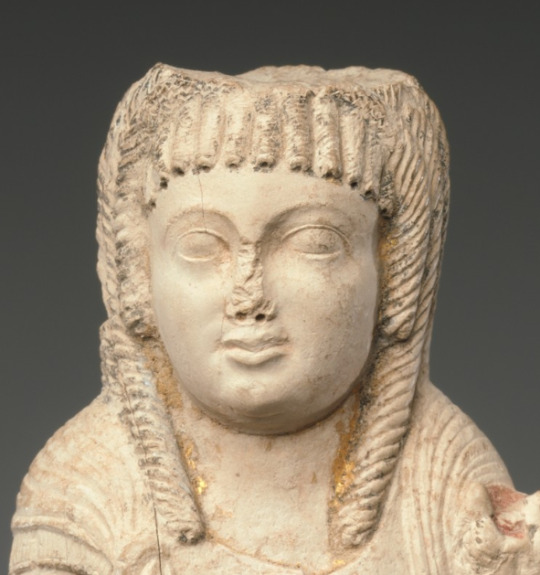



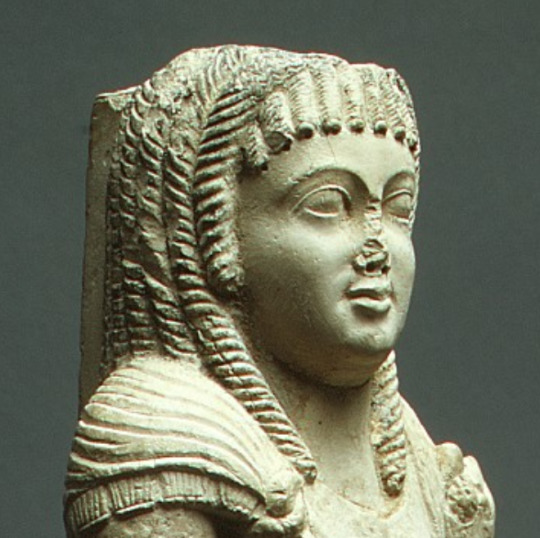

Statuette of Arsinoe II for her Posthumous Cult - Met Museum Collection
Inventory Number: 20.2.21 Ptolemaic Period, ca. 150–100 B.C. Location Information: Location Unlisted
Description:
The inscription on the back of this figure refers to Queen Arsinoe II as a goddess, indicating it was made after 270 B.C. when her cult was established at the time of her death in by her brother and husband, Ptolemy II. Gilding indicating divinity once covered her face, and traces still remain at the edges of her neckline.
While the overall frontal pose and disposition of the limbs in this small statue follows Egyptian traditions, the cornucopia the queen holds is a Greek divine attribute, and her corkscrew are strongly associated with Hellenistic traditions in Egypt. Features of the depiction – the small Cupid’s bow mouth and the large rounded eyes – are also elements from Greek style. Stylistic comparisons indicate this statue was created in the second half of the second century B.C.
#Statuette of Arsinoe II for her Posthumous Cult#Arsinoe II#ptolemaic#met museum#20.2.21#location unlisted#womens hair and wigs#PWHW
0 notes
Text
@Victoria, B.C., Canada:

Victoria ist der Hauptort der Provinz British Columbia und wurde 1843 besiedelt als Handelsposten der Hudson Bay Company. Sie ist damit die älteste Stadt an der Westküste und liegt auf Vancouver Island im äussersten Westen Kanadas. Heute zählt Victoria 90‘000 Einwohner.

Die Juan-de-Fuca-Strasse ist ab der Pazifik-Mündung auf einer Länge von rund 150 Kilometer eine überschaubare Wasserstrasse, in deren Mitte die Staatsgrenze der Vereinigten Staaten und Kanada verläuft. Danach geht das Gewässer in eine weite Bucht mit vielen kleinen Inseln und weiteren Wasserstrassen über, wo dahinter die Stadt Vancouver liegt.
Um 05h45 erreichen wir die Einfahrt zur Juan de Fuca Straight. Ein Schiff nach dem anderen reiht sich in die Fahrrinne ein. Es ist sonnig und doch ziehen vereinzelt Nebelfelder vorbei. Alle paar Minuten ertönt deswegen das Horn.

Um 10h30 kommt der Lotse an Bord und um 11h45 liegt die Seabourn Odyssey am Pier B South, Ogden Point. Zum Stadtzentrum ist es rund eine halbe Stunde zu Fuss und mit dem Shuttle, der ab 12h30 alle halbe Stunde fährt, nur ein paar Minuten. Also werden wir den Shuttle nehmen.
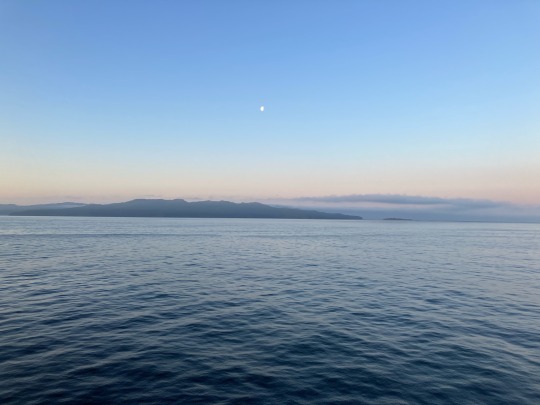

Sonnenaufgang über Vancouver Island

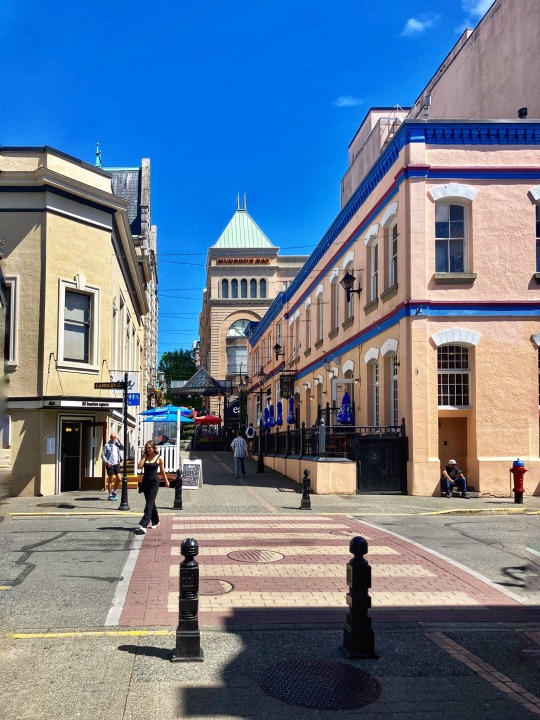



Nach dem Nachtessen um 21h00 habe ich noch dieses Foto zur blauen Stunde gemacht. Die Sonne geht hier spät unter und so ist die Stimmung grandios. Die Szenerie erinnert mich an die Schärengärten in Schweden. Und so geht ein langer Tag zu Ende. Wir sind ganz am Schluss unser Kreuzfahrt angelangt. Bis Vancouver sind es nur noch 80 Seemeilen. Das Schiff gleitet still und langsam mit 8 Knoten durch die Nacht. Die Koffer sind gepackt und stehen im Gang zur Abholung bereit. Für 07h00 ist die Ankunftszeit in Vancouver geplant. Kurz davor um ca. 06h15 werden wir unter der Lions Gate Bridge hindurchfahren und am Canada Place Pier anlegen.
0 notes
Text

Alexander The Great
Bronze portrait of Alexander the Great. Greek or Roman, Late Hellenistic to Hadrianic, ca 150 B.C - A.D. 138,NYC Metropolitan
68 notes
·
View notes
Text
A MYTHOLOGICAL ESSAY (TITANS)
Like many here, I love Greek mythology with its unlimited catalogue of gods and fantastic creatures. However, I've always had a problem adapting these stories. Beyond the writing of these figures which is an object of discussion in forums like these, I want to focus on a more A E S T H E T I C aspect.
Specially, about the Titans
NOW WHO ARE THE TITANS?
In Greek Mythology, the titans are the second generation of the gods (theoi) that ruled the cosmos, Cronus is the youngest of the titans when he overthrew his father, the primordial Uranus to later rule the heavens together with Rhea. To this point we know the famous story of Zeus against his father when he freed his brothers from the cage (A.K.A the belly) of Cronus and managed to defeat him and then he was sent to Tartarus.
Now my problem lies beyond its writing and symbolism, the design of this second generation of gods is a problem for me, especially in modern adaptations for the big screen and videogames. How many times have we not seen an adaptation and its design is completely "strange" to say the least?
BEHOLD THE TITANS
- God of War III (2010) -

WOW, I didn't know Thanos signed with Santa Barbara Studios to work as a stuntman for these people.
- Wrath of the Titans (2012) -
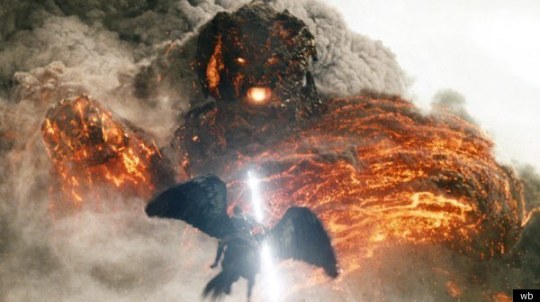
- Thank you Hollywood for making us believe that Kronos = Surtr (does not compute)
- Immortals (2011) -

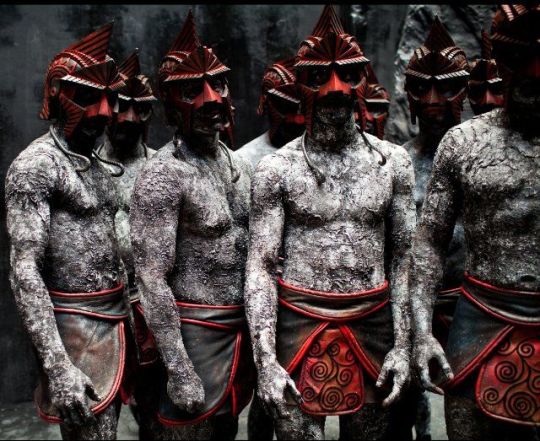
TRIVIA: Did you know that the titans had a strange kink with reinforcing bars :D (seriously, why grey?)
- Disney’s Hercules (1998-1999) -

Ahhh...
BACK TO THE TOPIC
i mean, we can argue all day long that they as a representation of natural forces is normal to possess supernatural forms in comparison to their descendants the Olympians who represent the human elements of society.
H O W E V E R
I find it too convenient that only these figures have an over the top design compared to their younger generation, (Even the Primordial Gods who are the pure elements of the universe and at the same time the parents of the Titans, they don’t have this monstrous aspect, just look at Nyx and Gaia from Marvel Comics) or we have even seen sometimes how some Titans have human form (Special case, Rhea, Helios and Eos from the God of War saga)
- Gaia and Nyx from Marvel Comics -
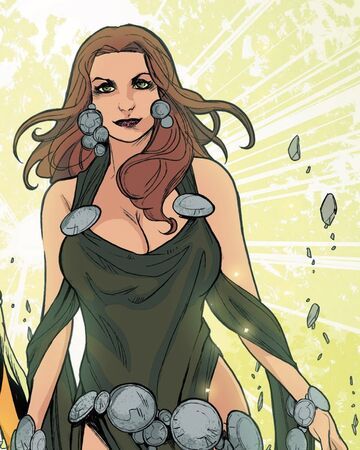

My primordial queens look better than their children... How is that possible?
- Helios, Rhea and Eos from the God of War saga -
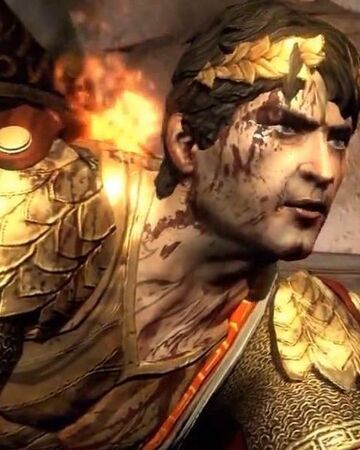

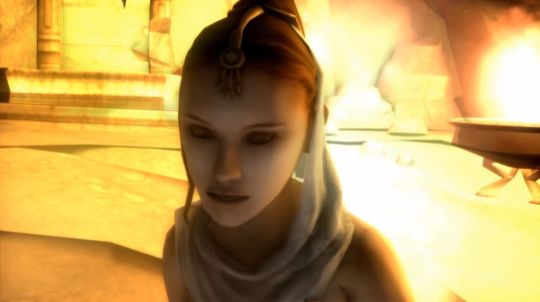
See? Designing characters like this is way better and more interesting than turning them into a generic foe as if they were taken from a Lord of the Rings bestiary.
Now, I can understand that this mistaken interpretation of these figures is due to the confusion of the Titans with the Giants (both groups are sons of Gaea who fought a war against the Olympic gods) So it’s kinda understandable that the confusion is palpable.
With all this covered there's someone who's wondering.
Is there any evidence of how the ancient greeks saw the Titans?
Fortunately the answer is YES . There is enough evidence to understand how this second generation of gods were seen by the ancient inhabitants of Greece, especially in two areas, sculpture and painting.
STATUES OF THE TITANS
- Farnese Atlas (150 B.C) -
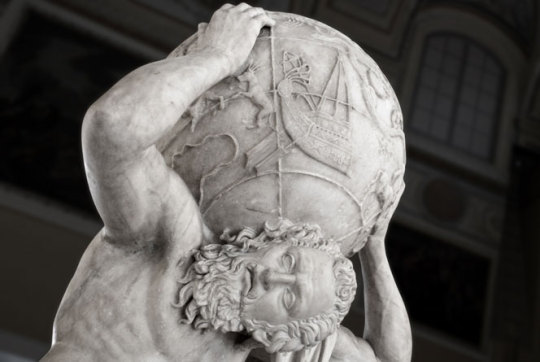
- Piece of an altar with Selene the moon titaness with either Phosphoros and Hesperus or the Dioscuri -
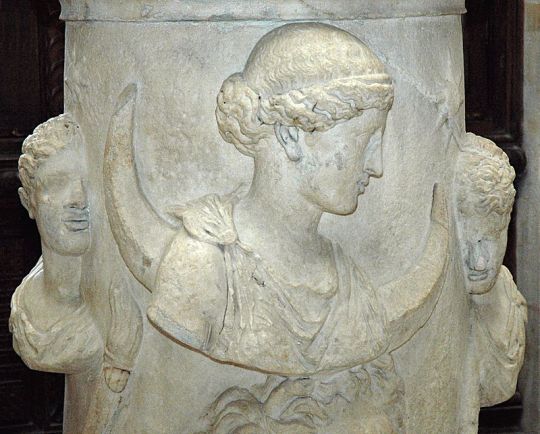
- Themis, the titaness of justice ( Chairestratos, c. 300 BCE) -
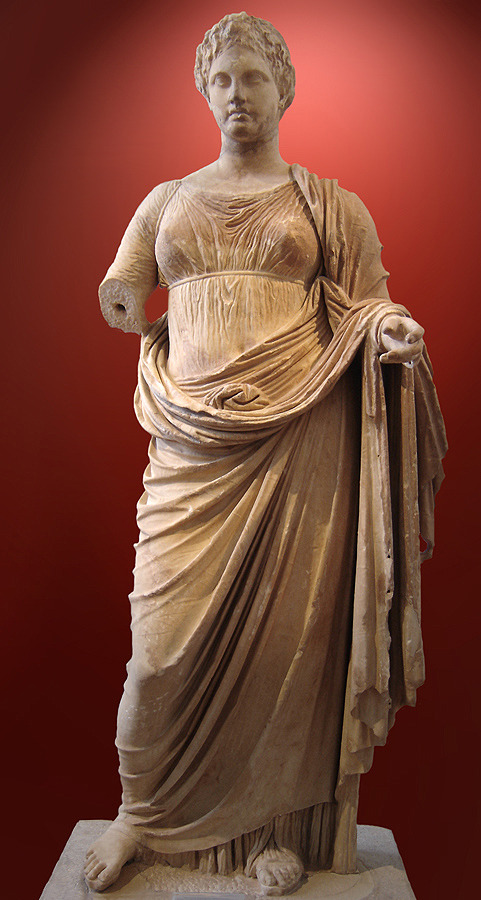
First of all, even if the former statues represent either titaness and a second generation titan (Atlas) We found no indication that these figures could be represented in a more exaggerated context.
But the most interesting part is the portraying of the titans in the old greek vase-paintings. WHY? Because the painting compared to the sculpture shows a more human focus on the gods, respecting their authority and power but implementing the qualities and defects that any mortal possesses. And the titans were not the exception when they were portrayed in this spectrum of the art.
AND THIS ARE THE PAINTINGS
- Atlas and Prometheus ( ca. 530 B.C.) -
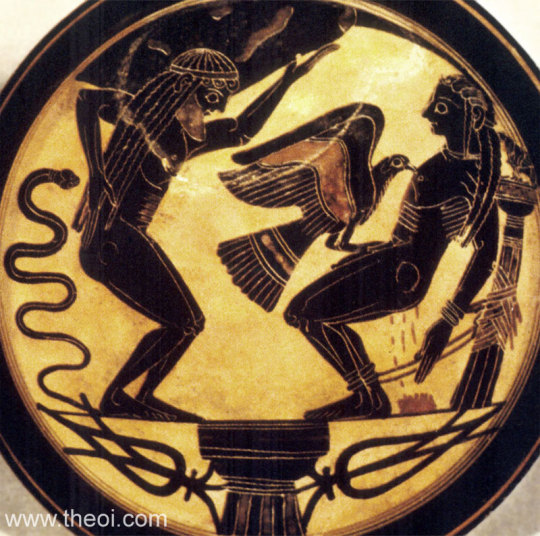
- Oceanus and Tethys (ca. 580 - 570 B.C.) -
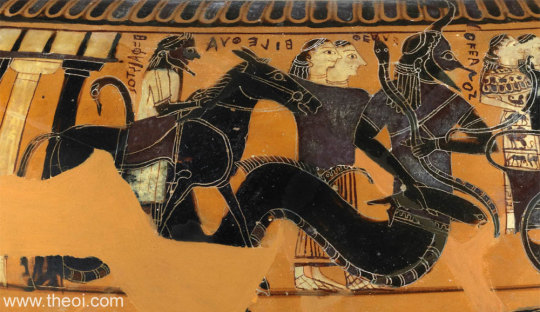
But for me, without a doubt, the most representative painting of the titans is this one.
- Cronus and Rhea (ca. 460 – 450 B.C.) -

If one day I was asked about how the Titans looked like? I will show them this image.
The first time you see this painting, the first thing you can imagine is the portrait of a normal greek family, but once you know who they really are, your perspective about this couple changes, there are no elements so over the top as a giant and monstrous Cronus and a normal stature Rhea that sometimes can generate confusion in people. Perhaps in a way the ancient Greeks wanted their mythological figures not to be too far removed from human nature, so that the people could identify with their deities in the most humane way possible even if the titans were not such adored figures compared to their descendants, the point still stands.
IN CONCLUSION
Lately the stories of Greek mythology have taken a more intimate approach to the relationships with the Greek gods, the fantastic elements are still present, but that is not the main value of these stories. How these figures relate to each other on a daily basis is perhaps an example of how the Greeks saw their gods. Beyond the powers, the titles, they saw people with qualities and defects.
So, if one day there is an adaptation to the screen about mythology and the titans make their appearance, I wish they were less over the top and with more human appearances and relationships, obviously keeping their corresponding power. Just a little thought :)
Thanks for reading my post :D peace ✌️ ✌️
#mythology#Greek Mythology#mythology discourse#discourse#greek mythology analysis#greek gods#essay writing#greek myths#greek myths discourse#greek mythology meta#Greek#titans mythology#titans greek mythology#I've wanted to write this for a long time.#greek representation#God of War#Hercules#clash of the titans#Greek discourse#long post#Zeus#Hera#Poseidon#Demeter#Hades#Hestia#Apollo#Artemis#Dionysus#Hermes
118 notes
·
View notes
Photo



Unknown
The Antikythera Ephebe (Youth), c. 340-330 BC. Late Classical bronze. National Archaeological Museum, Athens
Mostly thought to be a depiction of the mythological figure Paris presenting the Apple of Discord to Aphrodite, (if his right hand originally held a spherical object and not serpent medusa hair). The Ephebos/ephebe (male adolescent) is standing in contrapposto.
A 1900 discovery by Greek sponge-divers in the area of the ancient Antikythera shipwreck near the island of Antikythera, Greece.

The wreck, dated about 70–60 BC, also yielded the Antikythera Mechanism (astronomical analogue computer), the head of a Stoic philosopher, 36 marble sculptures including "Hercules", Ulysses, Diomedes, Hermes, Apollo, 3 marble statues of horses (a fourth was dropped during recovery and was lost on the sea floor), a bronze lyre, several pieces of glasswork and a hoard of coins. The coins included a disproportionate quantity of Pergamene cistophoric tetradrachms and Ephesian coins, leading to assume its origin was Ionia, perhaps Ephesus. - wiki
X-ray of a fragment of the Antikythera Mechanism - Computer History Museum
Seven large bronze fragments (A-G) and 75 minor pieces (1-75) have survived from ca 150 - 100 B.C. Not certain that the 75 small fragments belong to the Mechanism. It contained at least 30 gears, dials, scales, axles and pointers.
“Like Opening a Pyramid and Finding an Atomic Bomb”: [Yale University Professor] Derek de Solla Price and the Antikythera Mechanism ALEXANDER JONES. Institute for the Study of the Ancient World, New York University [PDF]
#Contrapposto#sculpture#bronze#classic#fragments#gr#sea#restoration#head#masterpiece#eyes#gaze#mechanical#essays#archaeology#xray#portrait#discovery
40 notes
·
View notes
Text

In Maya, ca means “two”, lak means “adjacent”, and mul signifies any artificial mound or pyramid, so Calakmul is the “City of the Two Adjacent Pyramids”. In ancient times, the city core was known as Ox Te’ Tuun, meaning “Three Stones”. The city existed for twelve centuries from (550 B.C. – 900 A.D.).
Calakmul’s southern location in the state of Quintana Roo places it in the center of the Peten Mayan Region. The inhabitants were influenced from both the north and south and belonged to a coalition that included the Maya settlements of El Mirador, Nakbé, and Uaxactún in the Maya lowlands. Calakmul was the largest and most powerful settlement in the coalition. This alliance was in constant conflict with its southern neighbors, especially Tikal located across the contemporary border of Guatemala.
During its heyday in the Classic Period 500 A.D. to 800 A.D., Calkmul was a powerhouse, with over 50,000 inhabitants, 6700 structures and various sacbes for commerce. The entire site is over 70 square kilometers (27 sq mi), though only a portion is open to the public. It is thought that the governing body of Calamkul had direct influence over settlements located up to 150 kms away, growing its direct impact from 50,000 inhabitants to over 200,000. If additional outer lying areas are included, Calakmul influenced over 1.5 million people. How the settlement was structured and built feels similar to Coba in the Yucatan, with a main plaza that led to various secondary urban centers. Its influence stood over 12 centuries and is thought to have more structures than any other excavated Maya settlements in the region.
2 notes
·
View notes
Text
Lunar and solar eclipses in ancient Astronomy
The ancient Chinese astronomer Shi Shen (fl. fourth century B.C.E.) was aware of the relation of the moon in a solar eclipse, as he provided instructions in his writing to predict them by using the relative positions of the moon and sun. The ‘radiating influence’ theory for a solar eclipse was opposed by the Chinese philosopher Wang Chong (27-97 C.E.), but he admits in his writing that it was nothing new. The Chinese astronomer and inventor Zhang Heng (78-139 C.E.) wrote of both solar eclipse and lunar eclipse in the publication of Ling Xian, 120 C.E.:
The sun is like fire and the moon like water. The fire gives out light and the water reflects it. Thus the moon’s brightness is produced from the radiance of the sun, and the moon’s darkness (pho) is due to (the light of) the sun being obstructed (pi). The side which faces the sun is fully lit, and the side which is away from it is dark. The planets (as well as the moon) have the nature of water and reflect light. The light pouring forth from the sun (tang jih chih chhung kuang) does not always reach the moon owing to the obstruction (pi) of the earth itself—this is called ‘an-hsü’, a lunar eclipse. When (a similar effect) happens with a planet (we call it) an occulation (hsing wei); when the moon passes across (kuo) (the sun’s path) then there is a solar eclipse (shih).

Furthermore, the later Chinese scientist Shen Kuo (1031-1095) used the models of lunar eclipse and solar eclipse in order to prove that the celestial bodies were round, not flat (which promoted spherical earth theory and went against flat earth theory). He wrote of this in his Dream Pool Essays of 1088 C.E., relating back when the Director of the Astronomical Observatory had asked Shen if the shapes of the sun and moon were round like balls or flat like fans. Shen Kuo explained his reasoning for the former:
If they were like balls they would surely obstruct each other when they met. I replied that these celestial bodies were certainly like balls. How do we know this? By the waxing and waning of the moon. The moon itself gives forth no light, but is like a ball of silver; the light is the light of the sun (reflected). When the brightness is first seen, the sun (-light passes almost) alongside, so the side only is illuminated and looks like a crescent. When the sun gradually gets further away, the light shines slanting, and the moon is full, round like a bullet. If half of a sphere is covered with (white) powder and looked at from the side, the covered part will look like a crescent; if looked at from the front, it will appear round. Thus we know that the celestial bodies are spherical.
When he asked Shen Kuo why eclipses occurred only on an occasional basis while in conjunction and opposition once a day, he wrote:
I answered that the ecliptic and the moon’s path are like two rings, lying one over the other, but distant by a small amount. (If this obliquity did not exist), the sun would be eclipsed whenever the two bodies were in conjunction, and the moon would be eclipsed whenever they were exactly in position. But (in fact) though they may occupy the same degree, the two paths are not (always) near (each other), and so naturally the bodies do not (intrude) upon one another.
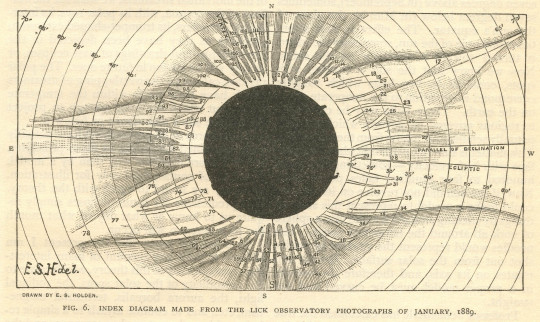
Historical observations of Solar Eclipses
Solar eclipses have been observed throughout history. Recent research has demonstrated that solar eclipses had been depicted in the fascinating mythology of ancient Egypt, and produced evidence that the ancient Egyptians observed solar eclipses over 4,500 years ago.
Ancient eclipse records made in China and Babylonia are believed to be over 4,000 years ago.
Beginning as far back as 2400 B.C., and especially during the Shang dynasty (1600 B.C. to 1046 B.C.)—a thousand years before the Chinese began to use paper—oracle bones were commonly used for divination.
Questions were posed, and animal bones or shells were then heated until they cracked into patterns that expert diviners were believed to “read.” The bones or shells were then inscribed with the interpretations and predictions.
Many astronomy-related inscriptions survive in these objects, but they are often cryptic and difficult to comprehend, sometimes lacking even the dates of the eclipses to which they refer.
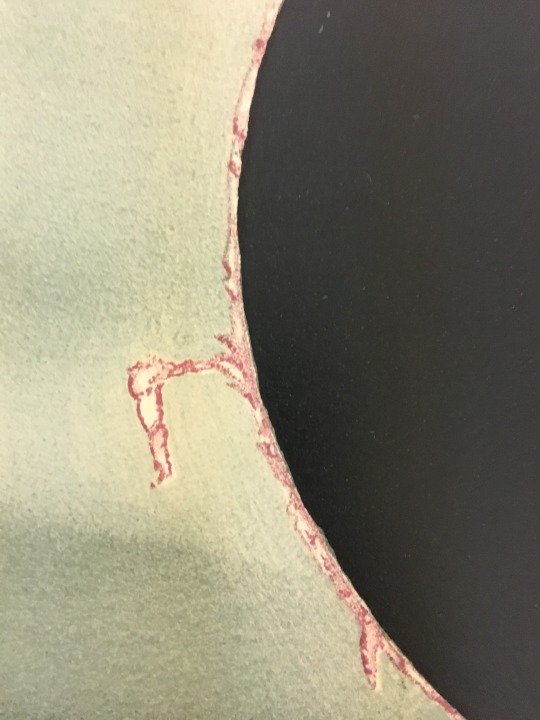
(above photo from 19th century)
“Because of the nature of the subject matter, oracle bones are not necessarily meant to be literal descriptions,”
Odenwald explained.
Accuracy aside, the bones are the earliest known evidence of an interest in tracking eclipses.
Ancient China‘s eclipse record keeping steadily improved over the centuries thanks to continued refinements in the calendar system driven by a search for signs that might tell the emperor’s future.
Systematic, dated eclipse records began in China in 719 B.C.
Astronomical computations enable astronomers to calculate the dates and paths of future and past eclipses with great accuracy. Some ancient eclipse records have been particularly significant to astronomers and historians as they enabled certain historical eras and events to be dated accurately. Astronomers can also examine ancient eclipse records to measure the rate of Earth’s spin about its axis over the past millenniums.
Astronomers from NASA’s Jet Propulsion Laboratory (JPL) used Chinese observations of five solar eclipses that occurred between 1161 B.C. and 1226 B.C. to study the rate of Earth’s axial rotation over the past 3,200 years. These eclipses were scratched on oxen shoulder blades in the Chinese city of Anyang.
By determining exactly when each of these eclipses was seen and where the Moon’s shadow fell on Earth in each eclipse, the scientists found that the day in 1200 B.C. was 0.047 second shorter than the present day.
By 20 B.C., Chinese astronomers realized the true nature of solar eclipses, and by 206 C.E., they were able to predict solar eclipses by analyzing the motion of the Moon.
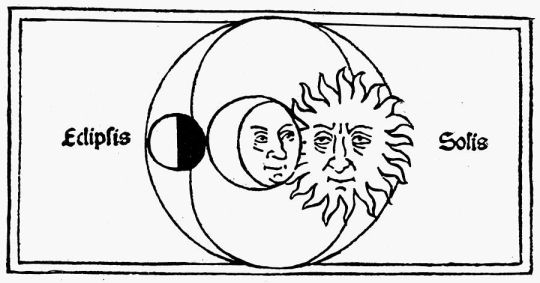
Astronomy flourished in Mesopotamia, the plain between the two great rivers Tigris and Euphrates, in the dawn of civilization. Like the Chinese and Egyptian astronomers, the Babylonian astronomers observed the motions of the Sun, Moon and planets carefully and kept records of the celestial events. They are also credited with remarkable contributions to ancient astronomy.
A fragment of a lost poem by Archilochus (ca. 680 B.C.–645 B.C.), who was a Greek poet and soldier, seems to clearly depict a total solar eclipse:
Nothing there is beyond hope,
nothing that can be sworn impossible,
nothing wonderful, since Zeus,
father of the Olympians,
made night from mid-day,
hiding the light of the shining Sun,
and sore fear came upon men.
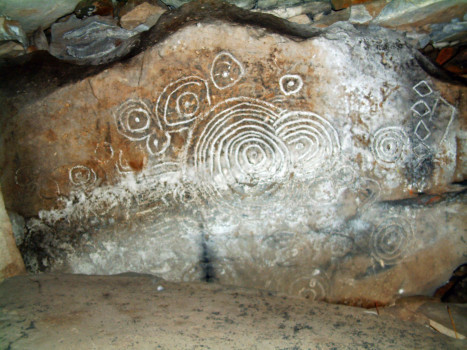
Herodotus, the father of history, who lived in the 5th century BC, cited that Thales (ca. 624 B.C.-547 B.C.), the Greek philosopher, predicted the solar eclipse of 28 May 585 B.C. that put an end to the conflict between the Lydians and the Medes.
Herodotus wrote:
… day was all of sudden changed into night. This event had been foretold by Thales, the Milesian, who forewarned the Ionians of it, fixing for it the very year in which it took place. The Medes and the Lydians when they observed the change, ceased fighting, and were alike anxious to have terms of peace agreed on.
Claudius Ptolemy (ca. 87-150 C.E.) wrote about eclipses in his epic work Almagest. His writings show that he studied the lunar orbit carefully and had a sophisticated scheme for predicting both solar and lunar eclipses.
One of the most important historical solar eclipses is that of the annular solar eclipse of 27 January 632. It was visible in Medina during the lifetime of Prophet Mohammad, Peace Be Upon Him (PBUH), and coincided with the death of his little son Ibrahim. The Prophet stated explicitly and definitely that the eclipses of the Sun and the Moon are not bad omens, but are cosmic spectacles that demonstrate the might and knowledge of Allah the Great.
The Egyptian astronomer Ibn Yunus (950-1009), who was regarded as one of the greatest observational astronomers of his time, made important, precise observations of lunar and solar eclipses in Cairo.
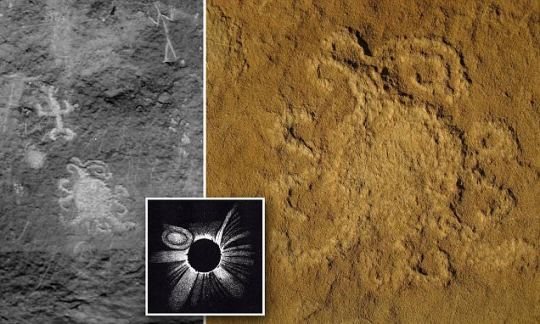
45 notes
·
View notes
Text

Roman bust of Alexander the Great, excavated from the ruins of Herculaneum.
-Blenheim Palace Oxfordshire, UK.
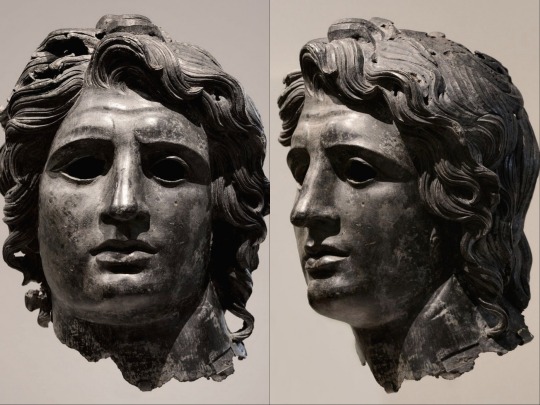
Bronze portrait of Alexander the Great. Greek or Roman, Late Hellenistic to Hadrianic ca. 150 B.c. - A.D. 138.
This posthumous portrait, with long "leonine" hair recalling Alexander's divine association with the hero Herakles, was probably from a cult statue.
-Metropolitan Museum of Art, NYC.
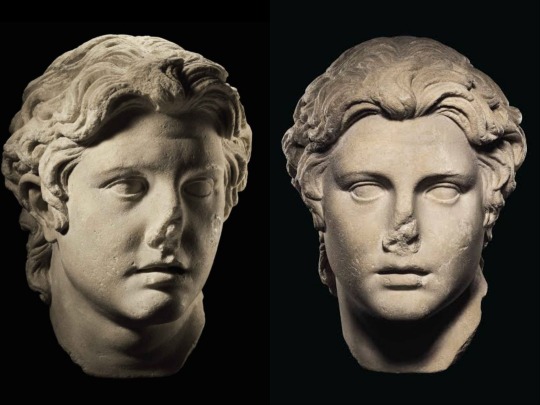
A Roman marble portrait of Alexander the Great. Circa 1st century AD.
The Macedonian ruler depicted lifesized, with a muscular neck, the laryngeal prominence bulging, his head turned to his right, his forehead creased, the deep-set eyes with modeled lids, his small mouth with parted lips, his thick, leonine hair swept up at the forehead in characteristic anastole.
-Antiquities, Sotheby's, London.
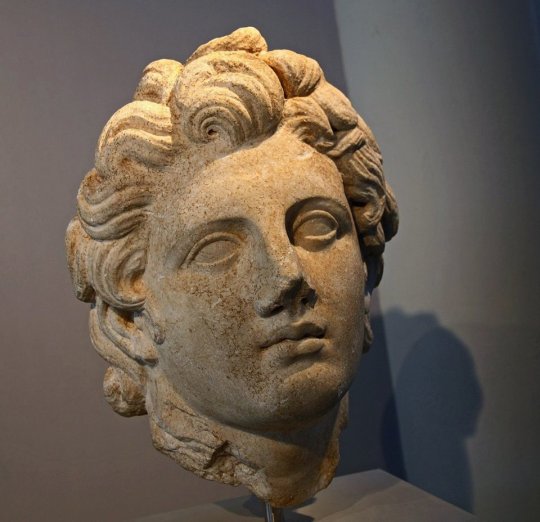
Marble head of a statue of Alexander the Great from the Court of the Passage of the Theoroi, Thasos, Greece. 2nd century AD.
Thasos was one of the first cities to worship Alexander as a god. An annual Alexandreia festival was held there on his birthday. This head features one of the most obvious examples of the "anastole" hairstyle characteristic of several portraits of Alexander.
-Thasos Archaeological Museum.
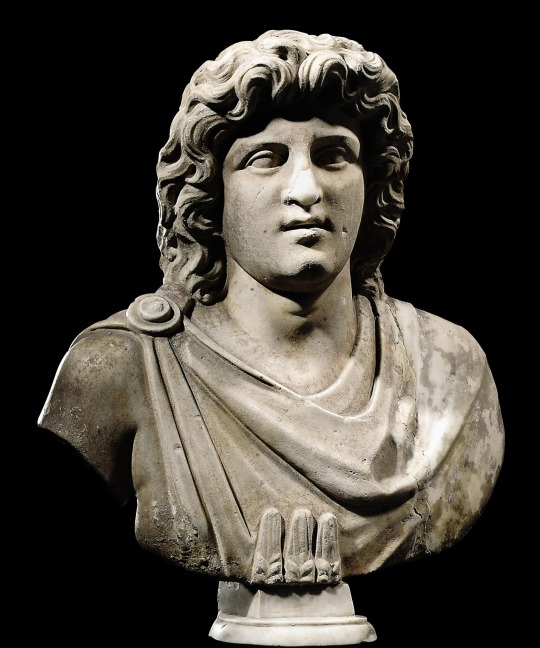
A Roman marble bust of Alexander Helios. Circa 1st Century AD.
His face framed by thick wavy hair, with seven recesses over the top of the head for insertion of bronze rays, wearing a chlamys fastened with a circular brooch at the shoulders, with three ears of wheat at the base of the bust, mounted.
-Formerly in a Swiss private collection, 1950s.
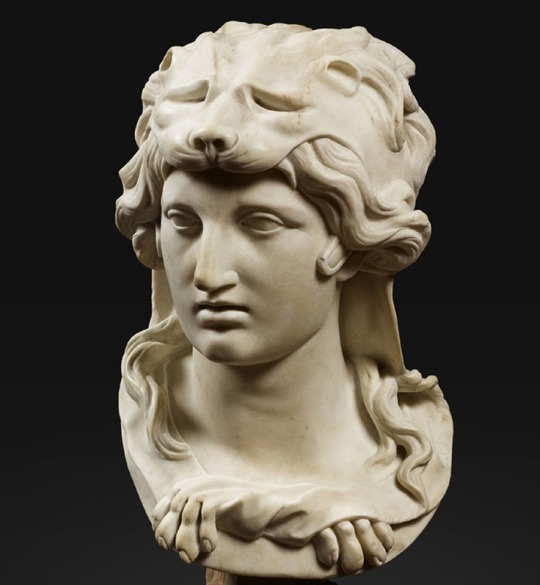
Bust of Alexander the great – Pierre II Legros known as Le Jeune.
This marble bust depicts Alexander the Great wearing a helmet reminiscent of his status of chief of the Macedonian armies. Wrapped in a lion’s skin, an attribute of Heracles, he also measures up to the twelve labors of this half mortal and half-deity hero, in light of his multiple military triumphs.
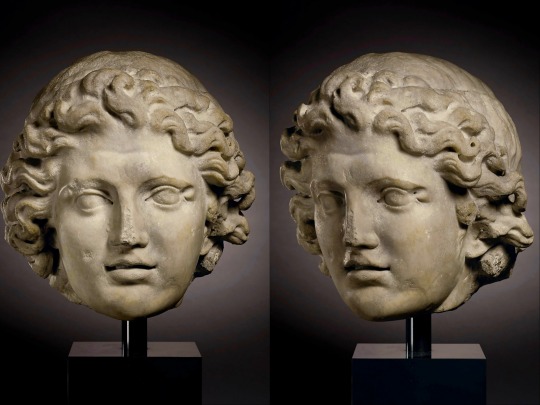
A monumental Roman marble head portrait of Alexander the Great.
Late Antonine period to early Severan period, circa late 2nd - early 3rd century AD.
-Marbury Hall, Cheshire, UK.
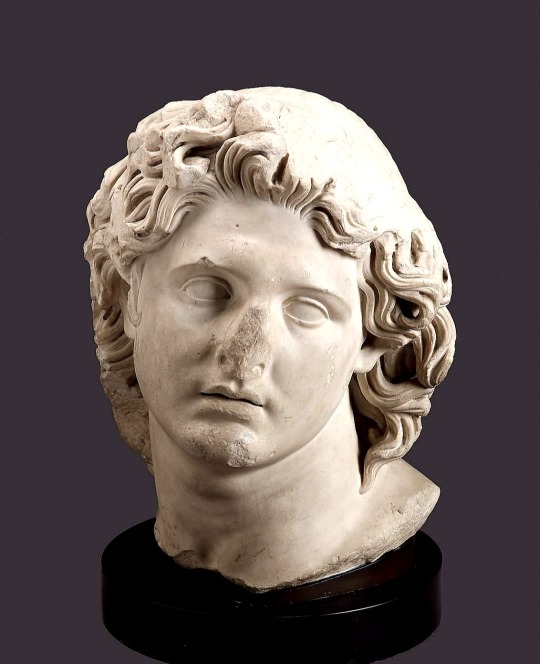
Head of Alexander the Great as Helios, Roman 2nd century AD.
Turned violently upward and to its own left, this head of Alexander the Great as Helios was carved to be let into a statue of nearly colossal proportions. The divine ruler was probably represented in the heroic nude with a cloak or aegis about the shoulders, concealing the join of the neck and shoulders. A ruler's rolled fillet encircles the head behind the leonine locks which enframe the face.
-Museum Of Fine Arts Boston.
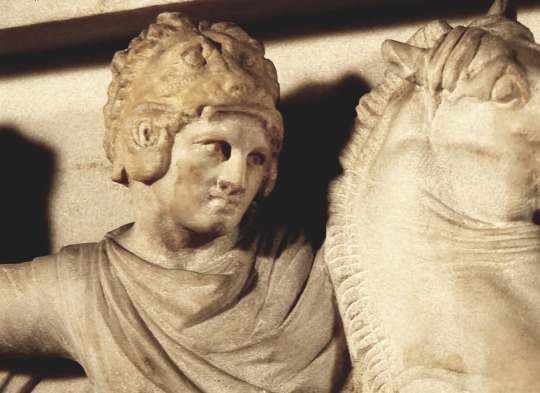
A detail of the relief on one of the long side of the Alexander sarcophagus. We see Alexander at the Battle of Issus (333 BC).
The King is shown wearing a lion-shaped helmet, which is perhaps a reference to Heracles, the hero who defeated the Nemean Lion, or otherwise serves to underscore his ferocity in battle.
-Istanbul Archaeological Museum.
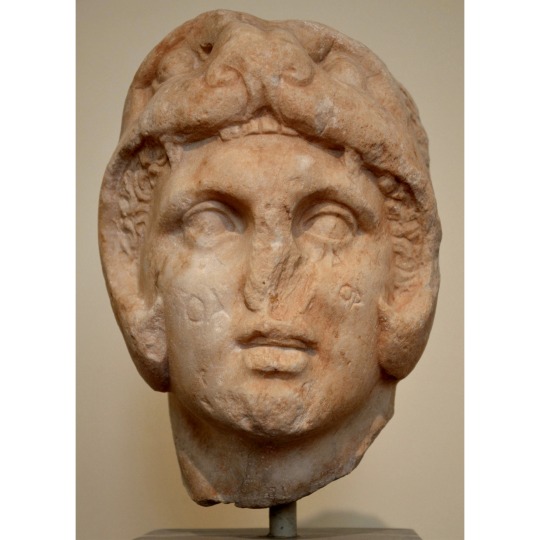
Alexander the Great wearing a lion skin, a frequent attribute on monetary portraits alluding to Herakles, his mythical ancestor; inscribed letters on the face are later additions.
Pentelic marble, ca. 300 BC. Found in Kerameikon, Athens.
-National Archaeological Museum of Athens.
25 notes
·
View notes
Text
For Tuesday, 16 March
UNIT 2: ANCIENT ROMAN ART: 2. Roman Portrait Sculpture

Marble bust of a man, mid-1st century A.D.
ASSIGNMENT: after sketching, compare this work to Greek funerary statues. List a few ways in which it differs -- excluding the fact that this is a portrait head instead of a full body representation.
MORE EXAMPLES: Can you figure out a characteristically Roman approach to portraits like these? Which one is your favorite, and why?
Marble bust of a bearded man, ca. A.D. 150–175
Marble head of an elderly woman, ca. 40–20 B.C.
“In antiquity, all marble sculpture was painted. Here, the indication of eyelashes can still be seen on the upper lid of the right eye, and traces of pigment remain on the same eye and on the hair. “
Marble bust of a woman. mid–3rd century A.D.
Marble portrait bust of a woman ca. A.D. 155–165
0 notes
Photo

Philae - The Jewel of the Nile:-**** جـــــــــــــزيرة فيله جـــوهره الــــنيل This little island, an alluvium covered rock of granite, only 460 x 150 m, is situated ca 8 km south of the Assuan Dam in Upper Egypt, in an area which in ancient times made out the border to Nubia. The wellknown name of Philae is Greek. It´s ancient Egyptian name was P-aaleq, meaning "End" or "Remote Place", which later turned into the Coptic Pilak. Incidentally, Philae is located at 24 degrees North and 33 degrees East, which is almost at the tropic of Cancer, i.e. this is where the sun reaches its´ highest point and stops at the summer solstice and turns in its course to go southwards again. It was probably a temple site since the 4th century B.C. according to blocks found from the time of Taharqa (690-664 B.C) Many of the buildings here were erected during the Ptolemeian times. As this was the cult center for the worship of Isis, people came here from all over Kemet and from countries far beyond, to worship the Great Isis, or Aset as Her ancient Egyptian name is. The legend has it that this was the place where Isis found the heart of Osiris and that She, after having collected his shattered body, buried him on the Island of Bigeh, just across the narrow stretch of water to the west. #iregipto #egypt #egyptpassion #isistemple #philaetemple #nileriver
4 notes
·
View notes
Text

~ Grave Stele of Herophanta and Posideos.
Culture: East Greek
Place of origin: Asia Minor (created); Smyrna, Turkey, Asia (found)
Date: ca. 150 B.C.
Medium: Marble
#ancient#ancient sculpture#ancient art#museum#archeology#history#archaeology#ancient history#ancient greek#grave stele#herophanta#posideos#smyrna#ca. 150 b.c.
283 notes
·
View notes
Text







Statuette of Arsinoe II for her Posthumous Cult - Met Museum Collection
Inventory Number: 20.2.21 Ptolemaic Period, ca. 150–100 B.C. Location Information: Location Unlisted
Description:
The inscription on the back of this figure refers to Queen Arsinoe II as a goddess, indicating it was made after 270 B.C. when her cult was established at the time of her death in by her brother and husband, Ptolemy II. Gilding indicating divinity once covered her face, and traces still remain at the edges of her neckline.
While the overall frontal pose and disposition of the limbs in this small statue follows Egyptian traditions, the cornucopia the queen holds is a Greek divine attribute, and her corkscrew are strongly associated with Hellenistic traditions in Egypt. Features of the depiction – the small Cupid’s bow mouth and the large rounded eyes – are also elements from Greek style. Stylistic comparisons indicate this statue was created in the second half of the second century B.C.
#Statuette of Arsinoe II for her Posthumous Cult#Arsinoe II#ptolemaic#met museum#20.2.21#location unlisted#womens clothing#PWC
0 notes
Text

~ Torso of Aphrodite.
Culture: Hellenistic or Roman
Date: ca. 200 B.C. - A.D. 150
Medium: Marble
0 notes
Photo

Bronze portrait of Alexander the Great
Greek or Roman, Late Hellenistic to Hadrianic ca. 150 B.C —138 A.D. The Metropolitan Museum of Art, NYC
Alexander the Great cultivated a visual image that projected his forceful character and leadership. Since there are no surviving fourth-century B.C. portraits attributed to his official court sculptor, Lysippos, later sculptures such as this monumental bronze provide an idea of his appearance. His portrait became the most famous in history and has been emulated by countless leaders from Hellenistic times to the present.
Divine cult centered around Alexander the Great arose during his lifetime and continued after his death in 323 B.C. He was worshipped in Greek cities, frequently in association with his successors, the Hellenistic kings who divided and ruled the vast kingdom he had created. The cult of Alexander continued during Roman times particularly in Macedonia, his homeland, and in Asia Minor, where cities traced their foundations to his rule. This posthumous portrait with long “leonine” hair recalling Alexander’s divine association with the hero Herakles, was probably from a cult statue.
#alexander the great#ancient greece#bronze#ancient art#ancient rome#i'm pretty sure i would've been an Alexander fangirl#look at him#smokeshow#those lips! that brow!#that haaaaair!#yowza#The Met#NYC/MTL2k17#queuedavers and queueriosities
32 notes
·
View notes
Text
Mass migration of painted-lady butterflies could be headed our way
A wave of delicately patterned butterflies headed north from California is setting B.C. lepidopterists’ — and other butterfly enthusiasts’ — hearts a-flutter.
An unusually large migration of painted-lady butterflies has been turning heads near Los Angeles, and there’s likely to be more sightings in B.C. this summer as well, according to local insect experts.
“We won’t see clouds of them, but people who know butterflies will probably notice more,” said University of B.C. entomologist Murray Isman. “The numbers tend to dissipate or be diluted as they travel north.”
Hatched in the deserts of Southern California, the painted ladies fly north, feeding on thistle and stinging-nettle nectar, often arriving in B.C. in the summer. This year’s mass migration is likely caused by substantial rainfall near the U.S.-Mexico border where the painted ladies lay their eggs. The newly hatched caterpillars were able to feast on a “super-bloom” of wildflowers, which aided their transformation to butterflies.
On social media people are posting videos of the small orange-and-black butterflies rapidly zipping along in their quest for food.
Imagine this happening outside of your windows for hours at a time.❤🦋
Video of migrating painted lady butterflies taken just outside of our #Carlsbad #Fish and #Wildlife Office in #California by @USFWS pic.twitter.com/UqV1xFnnlG
— US Fish and Wildlife, Pacific Southwest Region (@USFWS_PSW) March 18, 2019
Attack of the painted ladies in Oceanside, CA. #Butterflymigration pic.twitter.com/eTsPS3JwwW
— James Viscosi (@jamesviscosi) March 12, 2019
That journey should eventually take some of them to B.C., where they will spend their final days before dying. Unlike their cousin, the monarch butterfly, painted ladies don’t make a return migration south. When the weather gets cool, they die off, said Joel Gibson, the curator of entomology at the Royal B.C. Museum in Victoria.
The museum collects specimens and records sightings of butterflies, moths and insects. In some years, no painted ladies have been recorded in B.C., while in other years, they’ve been found as far north as Haida Gwaii and Yukon.
“I would guess that we’ll see more this year, but it’s always a guess,” said Gibson.
The museum is a valuable source of information on B.C. insects. The historical record allows researchers to determine if certain phenomenon are new or normal. It can also help to identify new species and those that have recently been introduced to the province. For example, while the curator hasn’t heard of a painted lady overwintering in B.C., if it began to happen it could tell scientists something about climate change, he said.
It’s expected that the painted ladies will arrive in B.C. in July or August, although they could make an early appearance in June.
“It’s nice to enjoy these natural phenomenon,” said Isman. “Especially as the urban landscape spreads, it’s a good reminder of nature.”

A large group of children gathered outside the Church of God in Vancouver in 2014 to release 300 home-bred butterflies.

Truman Ho, 8, examines the details of a painted-lady butterfly before releasing it in this photo from 2014.
Related
B.C. golf courses part of North American plan to attract Monarch butterflies
Butterfly species making comeback in B.C
Metro Vancouver butterfly entrepreneur provides bursts of living colour at poignant moments
twitter.com/glendaluymes
CLICK HERE to report a typo.
Is there more to this story? We’d like to hear from you about this or any other stories you think we should know about. Email [email protected].</p
Mass migration of painted-lady butterflies could be headed our way published first on https://weedkillerguide.tumblr.com/
0 notes